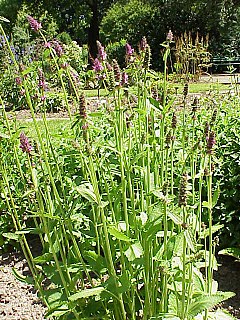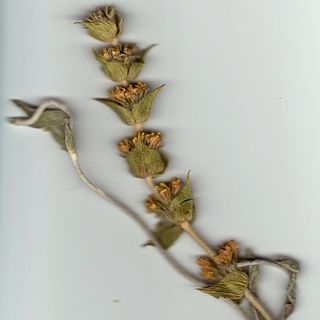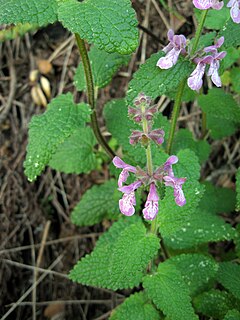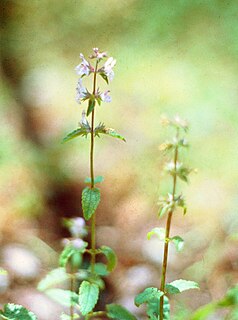
The Lamiaceae or Labiatae are a family of flowering plants commonly known as the mint or deadnettle or sage family. Many of the plants are aromatic in all parts and include widely used culinary herbs like basil, mentha, rosemary, sage, savory, marjoram, oregano, hyssop, thyme, lavender, and perilla, as well as other medicinal herbs such as catnip, salvia, bee balm, wild dagga, and oriental motherwort. Some species are shrubs, trees, or, rarely, vines. Many members of the family are widely cultivated, not only for their aromatic qualities, but also their ease of cultivation, since they are readily propagated by stem cuttings. Besides those grown for their edible leaves, some are grown for decorative foliage. Others are grown for seed, such as Salvia hispanica (chia), or for their edible tubers, such as Plectranthus edulis, Plectranthus esculentus, Plectranthus rotundifolius, and Stachys affinis. Many are also grown ornamentally, notably coleus, Plectranthus, and many Salvia species and hybrids.

Stachys is one of the largest genera in the flowering plant family Lamiaceae. Estimates of the number of species in the genus vary from about 300, to about 450. The type species for the genus is Stachys sylvatica. Stachys is in the subfamily Lamioideae. Generic limits and relationships in this subfamily are poorly known.

Stachys affinis, commonly called crosne, Chinese artichoke, Japanese artichoke, knotroot, or artichoke betony, is a perennial herbaceous plant of the family Lamiaceae, originating from China. Its rhizome is a root vegetable that can be eaten raw, pickled, dried or cooked.

Sideritis, also known as ironwort, mountain tea, and shepherd's tea, is a genus of flowering plants well known for their use as herbal medicine, commonly as an herbal tea. They are abundant in Mediterranean regions, the Balkans, the Iberian Peninsula and Macaronesia, but can also be found in Central Europe and temperate Asia.

Stachys byzantina, the lamb's-ear or woolly hedgenettle, is a species of flowering plant in the mint family Lamiaceae, native to Turkey, Armenia, and Iran. It is cultivated over much of the temperate world as an ornamental plant, and is naturalised in some locations as an escapee from gardens. Plants are very often found under the synonym Stachys lanata or Stachys olympica.

Stachys coccinea, the scarlet hedgenettle or Texas betony, is an ornamental plant of the family Lamiaceae, which is native from Arizona to Texas and from Baja California Sur, Mexico to Nicaragua.

Betonica officinalis, commonly known as common hedgenettle, betony, purple betony, wood betony, bishopwort, or bishop's wort, is a perennial grassland herb native to Europe, western Asia, and northern Africa.

Stachys sylvatica, commonly known as hedge woundwort, whitespot, or sometimes as hedge nettle, is a perennial herb growing to 80 cm tall in woodland and unmanaged grassland. In temperate zones of the northern hemisphere it flowers in July and August. The flowers are purple. The leaves, when crushed or bruised, give off an unpleasant fetid smell.

Stachys albens, also known as whitestem hedgenettle or white hedgenettle, is a mint endemic to California. S. albens flowers have a 2-lipped, 5-lobed calyx, which is densely cob-webby and white to pinkish in color with purplish veins. The plant is fuzzy all over, with opposite, triangular, serrate leaves, a square stem, a layered spike of many small flowers, and a minty smell if bruised.

Carcharodus flocciferus, the tufted skipper or tufted marbled skipper, is a butterfly of the family Hesperiidae.
Salvia eremostachya, the rose sage, sand sage, or desert sage, is a perennial shrub native to the western edge of the Colorado Desert. It reaches 2 to 3 ft high, with purplish green bracts on .75 in (1.9 cm) flowers that range from blue to rose to nearly white. The flowers grow in whorled clusters, blooming from April to November.

Stachys bullata is a species of flowering plant in the mint family known by the common name California hedgenettle.

Stachys chamissonis is a species of flowering plant in the mint family known by the common name coastal hedgenettle. It is native to the west coast of North America, where it grows in moist coastal habitat from Alaska to central California. This mint produces an erect stem 1 to 2 1⁄2 meters. It is hairy, glandular, and aromatic. The oppositely arranged leaves have pointed, wavy-edged blades up to 18 centimeters (7.1 in) long which are borne on petioles. The hairy, glandular inflorescence is made up of interrupted clusters of up to six flowers each. The flower has a deep pink tubular corolla which can be over 3 centimeters (1.2 in) long. The corollas are borne in hairy calyces of purple or purple-tinged sepals.

Stachys pycnantha is a species of flowering plant in the mint family known by the common name shortspike hedgenettle. It is native to California, where it is known from many types of mountain and foothill habitat. This mint produces several stems usually exceeding 60 centimeters in height. It is hairy and glandular and very aromatic. The leaves have lance-shaped or oval blades borne on short petioles. The inflorescence is usually a single cluster or interrupted series of a few clusters of flowers, with up to 12 flowers per cluster. The tubular corolla is up to a centimeter long and white to pink in color. It is borne in a hairy calyx of sepals.

Stachys recta, commonly known as stiff hedgenettle or perennial yellow-woundwort, is herbaceous perennial plant of the family Lamiaceae.

Stachys floridana is a species of betony in the mint family, Lamiaceae. It is native to the United States, where its true native range is probably limited to Florida, but today it is known throughout the Southeast as an introduced species and common weed. It occurs as far west as Texas, and it has been recorded in California. Its common names include Florida betony, Florida hedgenettle, and rattlesnake weed. It has been called wild artichoke, but it is not closely related to artichoke. The plant was the Florida Department of Agriculture's "Weed of the Month" for February 2010.
Ajugoides is a genus of plants in the family Lamiaceae, first described in 1915. It has only one known species, Ajugoides humilis, endemic to Japan. It has been reported from the islands of Honshu, Shikoku, and Kyushu.

Lamioideae is a subfamily of plants in the family Lamiaceae.

Stachys annua, called the annual yellow woundwort, is a widespread species of flowering plant in the hedgenettle genus Stachys, native to Europe, the Middle East, and western Siberia, and introduced in Cyprus, eastern North America, and Amur Oblast and Primorsky Krai in far eastern Russia. It is a common plant in fields, road verges and waste places.

















